Related Research Articles
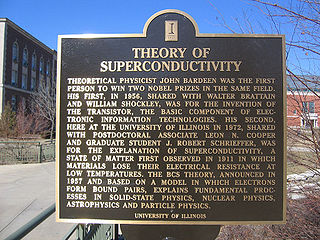
In physics, theBardeen–Cooper–Schrieffer (BCS) theory is the first microscopic theory of superconductivity since Heike Kamerlingh Onnes's 1911 discovery. The theory describes superconductivity as a microscopic effect caused by a condensation of Cooper pairs. The theory is also used in nuclear physics to describe the pairing interaction between nucleons in an atomic nucleus.

Superconductivity is a set of physical properties observed in certain materials where electrical resistance vanishes and magnetic fields are expelled from the material. Any material exhibiting these properties is a superconductor. Unlike an ordinary metallic conductor, whose resistance decreases gradually as its temperature is lowered, even down to near absolute zero, a superconductor has a characteristic critical temperature below which the resistance drops abruptly to zero. An electric current through a loop of superconducting wire can persist indefinitely with no power source.
Superconducting magnetic energy storage (SMES) systems store energy in the magnetic field created by the flow of direct current in a superconducting coil which has been cryogenically cooled to a temperature below its superconducting critical temperature. This use of superconducting coils to store magnetic energy was invented by M. Ferrier in 1970.
Unconventional superconductors are materials that display superconductivity which does not conform to conventional BCS theory or its extensions.
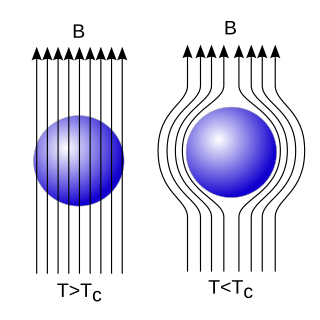
The Meissner effect is the expulsion of a magnetic field from a superconductor during its transition to the superconducting state when it is cooled below the critical temperature. This expulsion will repel a nearby magnet.
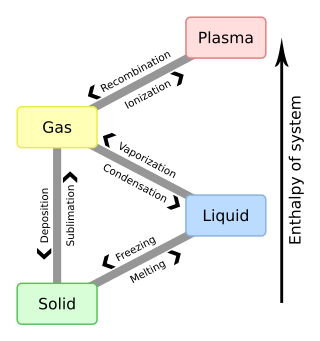
In chemistry, thermodynamics, and other related fields, a phase transition is the physical process of transition between one state of a medium and another. Commonly the term is used to refer to changes among the basic states of matter: solid, liquid, and gas, and in rare cases, plasma. A phase of a thermodynamic system and the states of matter have uniform physical properties. During a phase transition of a given medium, certain properties of the medium change as a result of the change of external conditions, such as temperature or pressure. This can be a discontinuous change; for example, a liquid may become gas upon heating to its boiling point, resulting in an abrupt change in volume. The identification of the external conditions at which a transformation occurs defines the phase transition point.

High-temperature superconductors are defined as materials with critical temperature above 77 K, the boiling point of liquid nitrogen. They are only "high-temperature" relative to previously known superconductors, which function at even colder temperatures, close to absolute zero. The "high temperatures" are still far below ambient, and therefore require cooling. The first break through of high-temperature superconductor was discovered in 1986 by IBM researchers Georg Bednorz and K. Alex Müller. Although the critical temperature is around 35.1 K, this new type of superconductor was readily modified by Ching-Wu Chu to make the first high-temperature superconductor with critical temperature 93 K. Bednorz and Müller were awarded the Nobel Prize in Physics in 1987 "for their important break-through in the discovery of superconductivity in ceramic materials". Most high-Tc materials are type-II superconductors.

Magnesium diboride is the inorganic compound with the formula MgB2. It is a dark gray, water-insoluble solid. The compound has attracted attention because it becomes superconducting at 39 K (−234 °C). In terms of its composition, MgB2 differs strikingly from most low-temperature superconductors, which feature mainly transition metals. Its superconducting mechanism is primarily described by BCS theory.

Yttrium barium copper oxide (YBCO) is a family of crystalline chemical compounds that display high-temperature superconductivity; it includes the first material ever discovered to become superconducting above the boiling point of liquid nitrogen at about 93 K.

Bismuth strontium calcium copper oxide (BSCCO, pronounced bisko), is a type of cuprate superconductor having the generalized chemical formula Bi2Sr2Can−1CunO2n+4+x, with n = 2 being the most commonly studied compound (though n = 1 and n = 3 have also received significant attention). Discovered as a general class in 1988, BSCCO was the first high-temperature superconductor which did not contain a rare-earth element.

In superconductivity, a type-II superconductor is a superconductor that exhibits an intermediate phase of mixed ordinary and superconducting properties at intermediate temperature and fields above the superconducting phases. It also features the formation of magnetic field vortices with an applied external magnetic field. This occurs above a certain critical field strength Hc1. The vortex density increases with increasing field strength. At a higher critical field Hc2, superconductivity is destroyed. Type-II superconductors do not exhibit a complete Meissner effect.

Andreev reflection (AR), named after the Russian physicist Alexander F. Andreev, is a type of particle scattering which occurs at interfaces between a superconductor (S) and a normal state material (N). It is a charge-transfer process by which normal current in N is converted to supercurrent in S. Each Andreev reflection transfers a charge 2e across the interface, avoiding the forbidden single-particle transmission within the superconducting energy gap.
Ferromagnetic superconductors are materials that display intrinsic coexistence of ferromagnetism and superconductivity. They include UGe2, URhGe, and UCoGe. Evidence of ferromagnetic superconductivity was also reported for ZrZn2 in 2001, but later reports question these findings. These materials exhibit superconductivity in proximity to a magnetic quantum critical point.
In chemistry, oxypnictides are a class of materials composed of oxygen, a pnictogen and one or more other elements. Although this group of compounds has been recognized since 1995, interest in these compounds increased dramatically after the publication of the superconducting properties of LaOFeP and LaOFeAs which were discovered in 2006 and 2008. In these experiments the oxide was partly replaced by fluoride.
Type-1.5 superconductors are multicomponent superconductors characterized by two or more coherence lengths, at least one of which is shorter than the magnetic field penetration length , and at least one of which is longer. This is in contrast to single-component superconductors, where there is only one coherence length and the superconductor is necessarily either type 1 or type 2. When placed in magnetic field, type-1.5 superconductors should form quantum vortices: magnetic-flux-carrying excitations. They allow magnetic field to pass through superconductors due to a vortex-like circulation of superconducting particles. In type-1.5 superconductors these vortices have long-range attractive, short-range repulsive interaction. As a consequence a type-1.5 superconductor in a magnetic field can form a phase separation into domains with expelled magnetic field and clusters of quantum vortices which are bound together by attractive intervortex forces. The domains of the Meissner state retain the two-component superconductivity, while in the vortex clusters one of the superconducting components is suppressed. Thus such materials should allow coexistence of various properties of type-I and type-II superconductors.
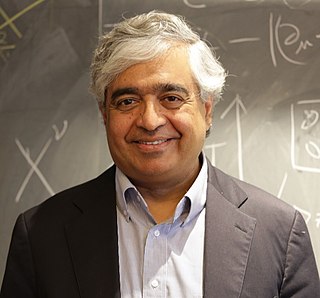
Subir Sachdev is Herchel Smith Professor of Physics at Harvard University specializing in condensed matter. He was elected to the U.S. National Academy of Sciences in 2014, and received the Lars Onsager Prize from the American Physical Society and the Dirac Medal from the ICTP in 2018. He was a co-editor of the Annual Review of Condensed Matter Physics from 2017–2019.
Heavy fermion superconductors are a type of unconventional superconductor.
The Fulde–Ferrell–Larkin–Ovchinnikov (FFLO) phase can arise in a superconductor in large magnetic field. Among its characteristics are Cooper pairs with nonzero total momentum and a spatially non-uniform order parameter, leading to normal conducting areas in the superconductor.

Frozen mirror image method is an extension of the method of images for magnet-superconductor systems that has been introduced by Alexander Kordyuk in 1998 to take into account the magnetic flux pinning phenomenon. The method gives a simple representation of the magnetic field distribution generated by a magnet outside an infinitely flat surface of a perfectly hard type-II superconductor in more general field cooled (FC) case, i.e. when the superconductor goes into superconducting state been already exposed to the magnetic field. The difference from the mirror image method, which deals with a perfect type-I superconductor, is that the perfectly hard superconductor screens the variation of the external magnetic field rather than the field itself.
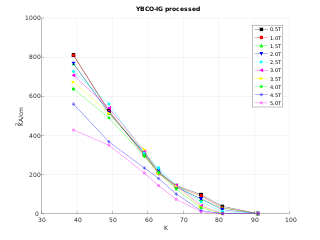
Rare-earth barium copper oxide (ReBCO) is a family of chemical compounds known for exhibiting high-temperature superconductivity (HTS). ReBCO superconductors have the potential to sustain stronger magnetic fields than other superconductor materials. Due to their high superconducting critical temperature and critical magnetic field, this class of materials are proposed for future use in technical applications where conventional low-temperature superconductors do not suffice. This includes magnetic confinement fusion reactors such as the ARC reactor, allowing a more compact and potentially more economical construction, and superconducting magnets to use in future particle accelerators to come after the Large Hadron Collider at CERN, which utilizes low-temperature superconductors.
References
- ↑ Pavel Diko; et al. (1995). "Influence of Y2BaCuO5 particles on the microstructure of YBa2Cu3O7-x (123)-Y2BaCuO5 (211) melt-textured superconductors". Phys. Rev. B . 52 (18): 13658–13664. Bibcode:1995PhRvB..5213658D. doi:10.1103/PhysRevB.52.13658. PMID 9980566.
- ↑ Kordyuk, Alexander A. (1998). "Magnetic levitation for hard superconductors" (PDF). Journal of Applied Physics . 83 (1): 610–611. Bibcode:1998JAP....83..610K. doi:10.1063/1.366648.